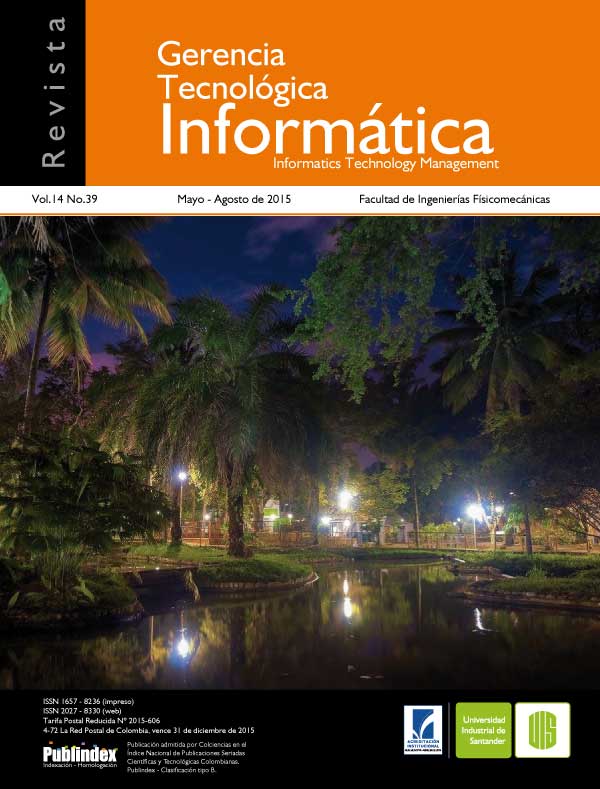Publicado 2016-08-08
Cómo citar
Resumen
Se presenta un nuevo algoritmo para el entrenamiento de redes neuronales perceptrón multicapa
llamado Acelerador Regresivo versión Gamma con Gradiente Local de Error. Este algoritmo se basa en
los mismos principios que rigen la actualización de parámetros en el algoritmo Acelerador Regresivo
versión Gamma. El algoritmo Acelerador Regresivo versión Gamma con Gradiente Local de Error se
valida mediante diferentes problemas relacionados con aproximación de funciones y reconocimiento de
patrones. Los resultados muestran buen comportamiento en cuanto a convergencia y generalización,
mejorando la tasa de aprendizaje del algoritmo “backpropagation”.
PALABRAS CLAVES: Redes Neuronales, Perceptrón Multicapa, Algoritmo ARγ, Gradiente Local de
Error, Reconocimiento de Patrones, Aproximación de Funciones.
Descargas
Referencias
- Szymczyk, P. (2015) Z-transform artificial neural networks. Neurocomputing, 168, 1207-1210.
- Guo, D., Zhang, Y., Xiao, Z., Mao, M., & Liu, J. (2015) Common nature of learning between BP-type and Hopfield-type neural networks. Neurocomputing, 167, 578-586.
- Chetehounaa, K., El Tabach, E., & Bouazaoui, L. (2015) Predicting the flame characteristics and rate of spread in fires propagating in a bed of Pinus pinaster using Artificial Neural Networks. Process Safety and Environmental Protection, 98, 50-56.
- Ata, R. (2015) Artificial neural networks applications in wind energy systems: a review. Renewable and Sustainable Energy Reviews, 49, 534-562.
- Brio, B., & Sanz A. (2007). Redes neuronales artificiales y sistemas borrosos, 3° Edición. México: Alfaomega Ra-Ma.
- Mirjalili, S., Mirjalili, S., & Lewis, A. (2014) Let a biogeography-based optimizer train your MultiLayer Perceptron. Information Sciences, 269, 188-209.
- Malalur, S., Manry, M., & Jesudhas, P. (2015) Multiple optimal learning factors for the multi-layer perceptron. Neurocomputing, 149, 1490-1501.
- Albuquerque, V., Alexandria, A., Cortez, P., & Tavares, J. (2009). Evaluation of multilayer perceptron and self-organizing map neural network topologies applied on microstructure segmentation from metallographic images. NDT & E International, 42, 7, 644–651.
- Jayalakshmi, T., & Santhakumaran, A. (2011). Statistical normalization and back propagation for classification. International Journal of Computer Theory and Engineering, 3, 1, 1793–8201.
- Zhang, J., Ji, N., Liu, J., Pan, J., & Meng, D. (2015) Enhancing performance of the backpropagation algorithm via sparse response regularization. Neurocomputing, 153, 20-40.
- Yasin, U., & Kemal, B. (2012). A second look at the performance of neural networks for keystroke dynamics using a publicly available dataset. Computers & Security, 3, 717–726.
- Mukherjee, I., & Routroy, S. (2012). Comparing the performance of neural networks developed by using levenberg-marquardt and quasi-newton with the gradient descent algorithm for modeling a multiple response grinding process. Expert Systems with Applications, 39, 3, 2397–2407.
- Jojoa, P. (2003). Um algoritmo acelerador de parâmetros. Tesis de Doctorado no publicada. Escola Polit’ecnica da Universidad de S’ao Paulo, S’ao Paulo, Brasil.
- Castro, F. (2014). Diseño de un algoritmo de aprendizaje para redes neuronales MLP basado en las propiedades del algoritmo acelerador regresivo versión γ. Tesis de Maestría. Universidad del Cauca, Popayán, Colombia.
- Haykin, S. (1998) Neural networks: a comprehensive foundation, 2° Edición. Ontario: McMaster University.
- Estudillo, A. C. (2005) Modelos de regresión basados en redes neuronales de unidades producto diseñadas y entrenadas mediante algoritmos de optimización híbrida: aplicaciones. Tesis de Doctorado. Universidad de Granada.
- Demuth, H., Beale, M., & Hagan, M. (2010). Neural network toolbox 7, user’s guide. Natick, MA: The MathWorks.
- Asuncion, A., & Newman, D. (2007). UCI Machine Learning Repository. Recuperado (2014, Enero14) de http://mlearn.ics.uci.edu/MLRepository.html
- Principe, J., Euliano, N., & Lefebvre, W. (2000) Neural adaptive systems: Fundamentals through simulation. New York: John Wiley & Sons.
- Zhen-Guo, C., Tzu-An, C., & Zhen-Hua, C. (2011) Feed-Forward neural networks training: A comparison between genetic algorithm and backpropagation learning algorithm. Information and Control ICIC International, 7, 10, 5839-5850.
